Assessment One: Cultural Plunge – Analytical Reflection on Diversity
VerifiedAdded on 2021/04/21
|13
|4661
|203
Report
AI Summary
This report presents a reflection on a cultural plunge undertaken to understand the socio-cultural differences between indigenous Australians and the white population. The author details their experience visiting an Aboriginal day care center, highlighting the linguistic and cultural differences encountered. The report explores the author's initial expectations and discomfort, contrasting them with the welcoming and inclusive environment they experienced. The analysis focuses on the importance of diversity in early childhood education, the impact of racial discrimination, and the need for a more inclusive society. The author reflects on their changed perspectives, emphasizing the value of cultural diversity and the need to move beyond stereotypes and discriminatory practices. The report underscores the significance of embracing socio-cultural differences and providing multicultural education from an early age to foster a more equitable and understanding society, particularly within the context of the post-colonial era. The author reflects on the importance of valuing indigenous languages and cultures within the broader educational and societal frameworks.
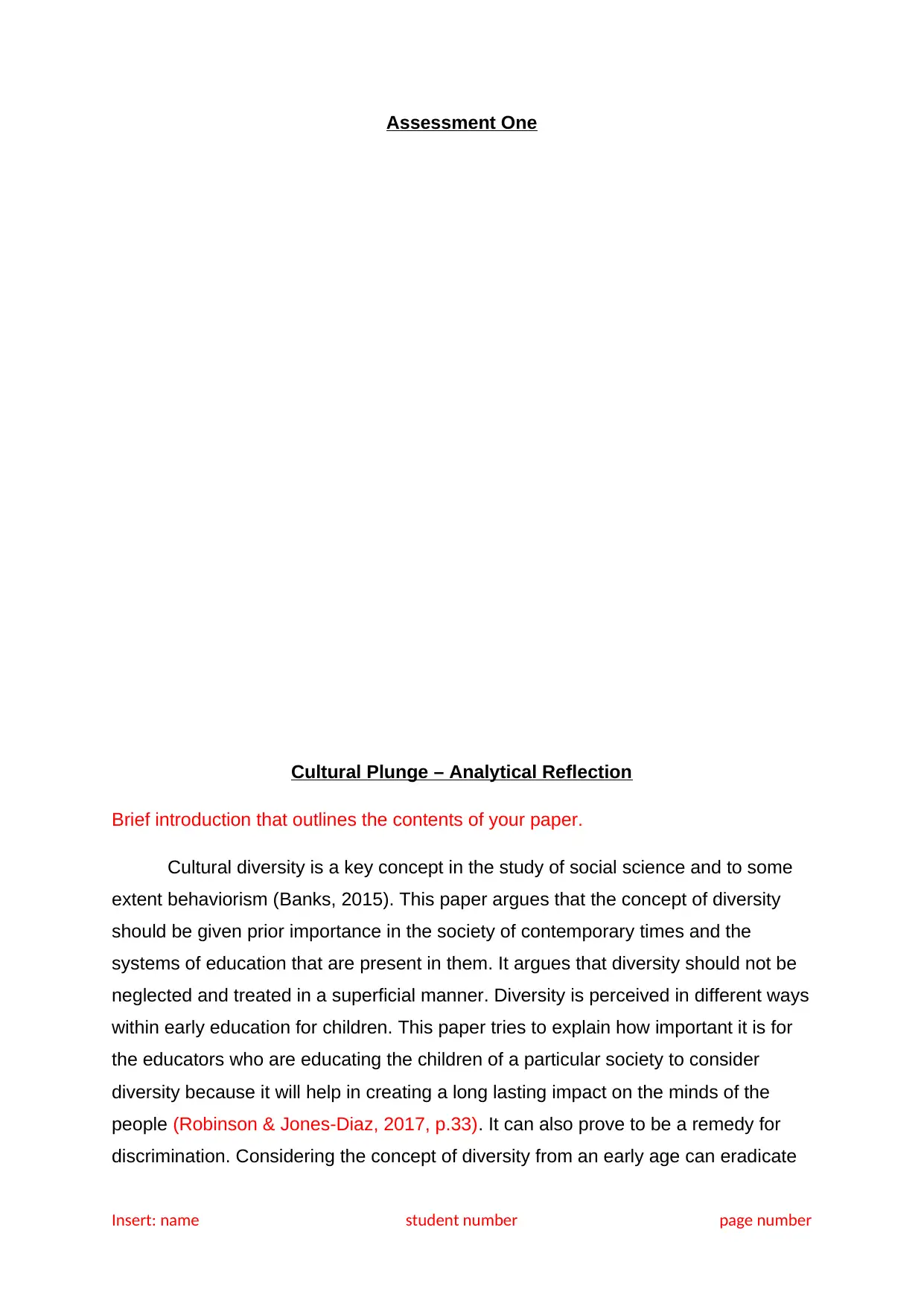
Assessment One
Cultural Plunge – Analytical Reflection
Brief introduction that outlines the contents of your paper.
Cultural diversity is a key concept in the study of social science and to some
extent behaviorism (Banks, 2015). This paper argues that the concept of diversity
should be given prior importance in the society of contemporary times and the
systems of education that are present in them. It argues that diversity should not be
neglected and treated in a superficial manner. Diversity is perceived in different ways
within early education for children. This paper tries to explain how important it is for
the educators who are educating the children of a particular society to consider
diversity because it will help in creating a long lasting impact on the minds of the
people (Robinson & Jones-Diaz, 2017, p.33). It can also prove to be a remedy for
discrimination. Considering the concept of diversity from an early age can eradicate
Insert: name student number page number
Cultural Plunge – Analytical Reflection
Brief introduction that outlines the contents of your paper.
Cultural diversity is a key concept in the study of social science and to some
extent behaviorism (Banks, 2015). This paper argues that the concept of diversity
should be given prior importance in the society of contemporary times and the
systems of education that are present in them. It argues that diversity should not be
neglected and treated in a superficial manner. Diversity is perceived in different ways
within early education for children. This paper tries to explain how important it is for
the educators who are educating the children of a particular society to consider
diversity because it will help in creating a long lasting impact on the minds of the
people (Robinson & Jones-Diaz, 2017, p.33). It can also prove to be a remedy for
discrimination. Considering the concept of diversity from an early age can eradicate
Insert: name student number page number
Paraphrase This Document
Need a fresh take? Get an instant paraphrase of this document with our AI Paraphraser

discrimination from societies. This paper intends to address the cultural differences
in a first-hand account of the author and discuss about the risks associated with a
cultural plunge. Specifically, this paper intends to describe the socio cultural
differences of the indigenous people living in Australia with the whites and the
impacts on them due to the cultural plunge.
a) Justification
Identity concepts – How do you see yourself in terms of social positioning, identity
categories and elements of subjectivity?
In order to justify, compare and analyze the factors related to diversity and the
cultural plunge, it is important to consider the factors of division by 'normal' and 'other
from the normal' type of population. Simply put, this is nothing but the dominance by
the numerically superior race who indirectly happen to be culturally superior. This
division creates social inequality or 'diversity’ (Banks, 2014). In other words, these
factors are simply the benchmarks which are required to be considered for
conducting the analysis.
As a matter of fact, the normality and abnormality are relative terms
deepening on the circumstances and location. I consider myself to fall under the
'normal' category in the location that I reside in. I will be discussing the socio-cultural
differences between the whites and the aborigines and in this regard, we white
people are the majority here in Australia. Specifically, I intend to discuss the
requirement for considering and appraising diversity in early childhood education as
it has the capability of elimination of the racial discrimination president in the society
today due to the lack of observation of these factors (Moss, Dahlberg & Pence,
2013). I personally believe in the importance of eradication of the toxic concept of
racial discrimination to attain a sustainable society.
Rationale for the plunge – Why did you chose this particular plunge based on key
identity concepts/aspects of self (social positioning, identity categories and elements
of subjectivity)?
The aspect of the existence of difference and diversity in early childhood
education is a deep concept that can affect the individuals, both the majority and
Insert: name student number page number
in a first-hand account of the author and discuss about the risks associated with a
cultural plunge. Specifically, this paper intends to describe the socio cultural
differences of the indigenous people living in Australia with the whites and the
impacts on them due to the cultural plunge.
a) Justification
Identity concepts – How do you see yourself in terms of social positioning, identity
categories and elements of subjectivity?
In order to justify, compare and analyze the factors related to diversity and the
cultural plunge, it is important to consider the factors of division by 'normal' and 'other
from the normal' type of population. Simply put, this is nothing but the dominance by
the numerically superior race who indirectly happen to be culturally superior. This
division creates social inequality or 'diversity’ (Banks, 2014). In other words, these
factors are simply the benchmarks which are required to be considered for
conducting the analysis.
As a matter of fact, the normality and abnormality are relative terms
deepening on the circumstances and location. I consider myself to fall under the
'normal' category in the location that I reside in. I will be discussing the socio-cultural
differences between the whites and the aborigines and in this regard, we white
people are the majority here in Australia. Specifically, I intend to discuss the
requirement for considering and appraising diversity in early childhood education as
it has the capability of elimination of the racial discrimination president in the society
today due to the lack of observation of these factors (Moss, Dahlberg & Pence,
2013). I personally believe in the importance of eradication of the toxic concept of
racial discrimination to attain a sustainable society.
Rationale for the plunge – Why did you chose this particular plunge based on key
identity concepts/aspects of self (social positioning, identity categories and elements
of subjectivity)?
The aspect of the existence of difference and diversity in early childhood
education is a deep concept that can affect the individuals, both the majority and
Insert: name student number page number
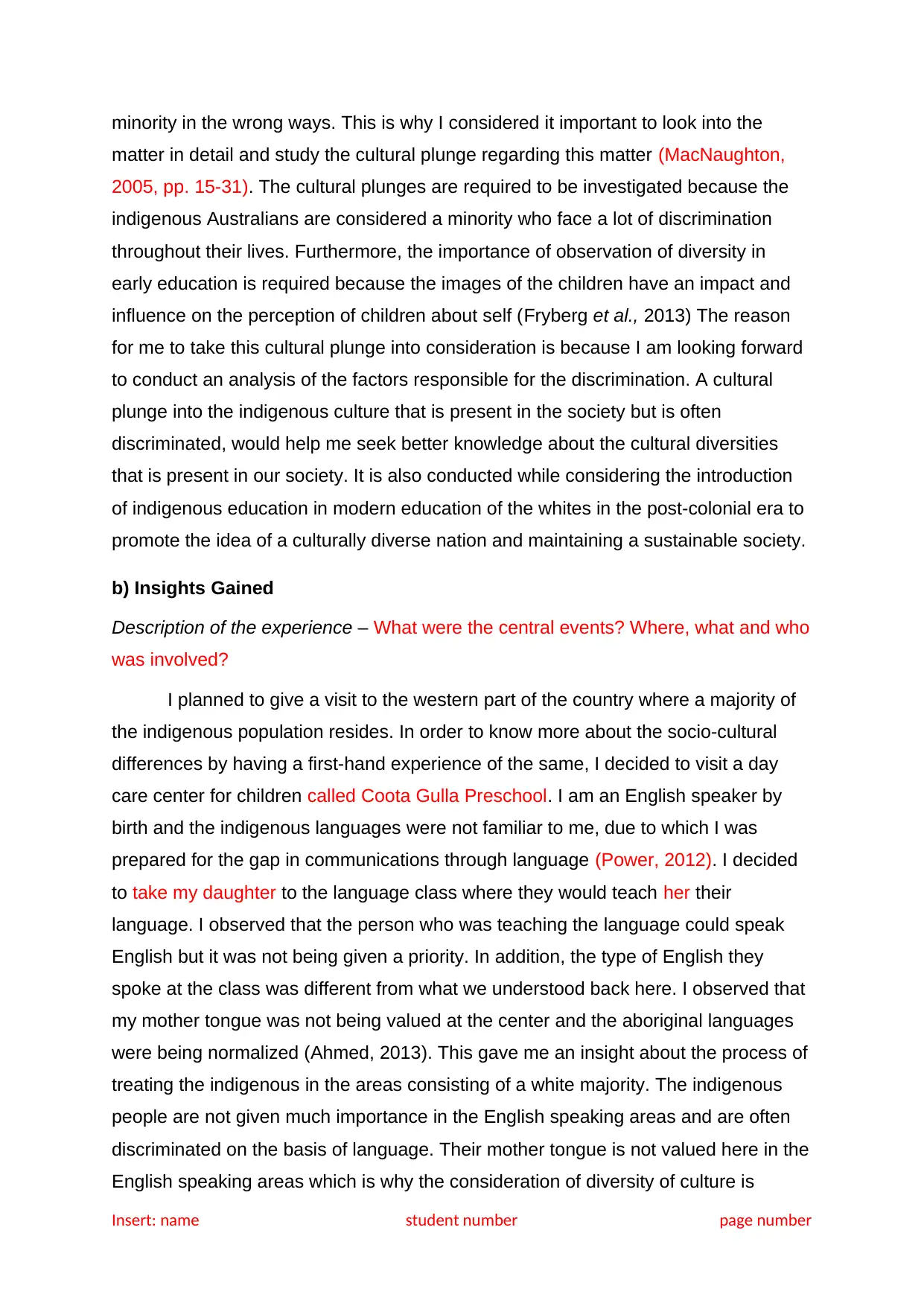
minority in the wrong ways. This is why I considered it important to look into the
matter in detail and study the cultural plunge regarding this matter (MacNaughton,
2005, pp. 15-31). The cultural plunges are required to be investigated because the
indigenous Australians are considered a minority who face a lot of discrimination
throughout their lives. Furthermore, the importance of observation of diversity in
early education is required because the images of the children have an impact and
influence on the perception of children about self (Fryberg et al., 2013) The reason
for me to take this cultural plunge into consideration is because I am looking forward
to conduct an analysis of the factors responsible for the discrimination. A cultural
plunge into the indigenous culture that is present in the society but is often
discriminated, would help me seek better knowledge about the cultural diversities
that is present in our society. It is also conducted while considering the introduction
of indigenous education in modern education of the whites in the post-colonial era to
promote the idea of a culturally diverse nation and maintaining a sustainable society.
b) Insights Gained
Description of the experience – What were the central events? Where, what and who
was involved?
I planned to give a visit to the western part of the country where a majority of
the indigenous population resides. In order to know more about the socio-cultural
differences by having a first-hand experience of the same, I decided to visit a day
care center for children called Coota Gulla Preschool. I am an English speaker by
birth and the indigenous languages were not familiar to me, due to which I was
prepared for the gap in communications through language (Power, 2012). I decided
to take my daughter to the language class where they would teach her their
language. I observed that the person who was teaching the language could speak
English but it was not being given a priority. In addition, the type of English they
spoke at the class was different from what we understood back here. I observed that
my mother tongue was not being valued at the center and the aboriginal languages
were being normalized (Ahmed, 2013). This gave me an insight about the process of
treating the indigenous in the areas consisting of a white majority. The indigenous
people are not given much importance in the English speaking areas and are often
discriminated on the basis of language. Their mother tongue is not valued here in the
English speaking areas which is why the consideration of diversity of culture is
Insert: name student number page number
matter in detail and study the cultural plunge regarding this matter (MacNaughton,
2005, pp. 15-31). The cultural plunges are required to be investigated because the
indigenous Australians are considered a minority who face a lot of discrimination
throughout their lives. Furthermore, the importance of observation of diversity in
early education is required because the images of the children have an impact and
influence on the perception of children about self (Fryberg et al., 2013) The reason
for me to take this cultural plunge into consideration is because I am looking forward
to conduct an analysis of the factors responsible for the discrimination. A cultural
plunge into the indigenous culture that is present in the society but is often
discriminated, would help me seek better knowledge about the cultural diversities
that is present in our society. It is also conducted while considering the introduction
of indigenous education in modern education of the whites in the post-colonial era to
promote the idea of a culturally diverse nation and maintaining a sustainable society.
b) Insights Gained
Description of the experience – What were the central events? Where, what and who
was involved?
I planned to give a visit to the western part of the country where a majority of
the indigenous population resides. In order to know more about the socio-cultural
differences by having a first-hand experience of the same, I decided to visit a day
care center for children called Coota Gulla Preschool. I am an English speaker by
birth and the indigenous languages were not familiar to me, due to which I was
prepared for the gap in communications through language (Power, 2012). I decided
to take my daughter to the language class where they would teach her their
language. I observed that the person who was teaching the language could speak
English but it was not being given a priority. In addition, the type of English they
spoke at the class was different from what we understood back here. I observed that
my mother tongue was not being valued at the center and the aboriginal languages
were being normalized (Ahmed, 2013). This gave me an insight about the process of
treating the indigenous in the areas consisting of a white majority. The indigenous
people are not given much importance in the English speaking areas and are often
discriminated on the basis of language. Their mother tongue is not valued here in the
English speaking areas which is why the consideration of diversity of culture is
Insert: name student number page number
⊘ This is a preview!⊘
Do you want full access?
Subscribe today to unlock all pages.

Trusted by 1+ million students worldwide

required in the education system. It is required to be implemented in the early
childhood education procedure.
Reactions to the plunge – Why did you expect to feel like ‘the other’ [before]?
The conceptions of being defined as normal or the other are relative
depending on the circumstances and situational activities. It is the minority that is
usually termed as the other in regards to the 'normal' population of the whites in
Australia. In the incident of being in an aboriginal day care center for children, where
the majority would be the indigenous population of Australia, I was bound to feel like
an outsider or 'the other' half of the classification that has been implemented in our
society. This was because the majority of the population was outside of my race.
Therefore, they had customs much different from ours (MacNaughton, 2005, pp. 6-
13). They did not speak English, which is considered to be the language of the
'normal' population in the areas resided by the whites. Instead, their own language
was considered 'normal' and all the other languages from different races as 'others.'
Usually, the indigenous population residing in the white areas are looked down upon
and discriminated based on their race and language differences (Fredericks, 2013). I
have grown up being a part of such a society that discriminates and hence I used to
consider every society to be similar. I was thinking throughout that the indigenous
people had a similar thought process about the whites and they would treat me like
'others.'
Emotionally, how did you actually experience being ‘the other’ [during and after]?
The incident of visiting a day care center for the children of the indigenous
people, gave me a whole new different experience of witnessing the diversity of
culture first-hand. The experience was phenomenal (Summer, 2014, pp.193-200). I
observed that even though there were differences in between the two societies along
with language and cultural distinctions, I was not considered an outsider. I did not
face any racial discrimination even though I was white, which was the 'other' form of
people in their society (Robinson & Jones-Diaz, 2017, pp. 1-4). I was treated as their
guest and they did everything that they could to serve me to which I obliged. This
experience of being amongst the minority taught me several lessons. It taught me
how we should consider giving prior importance in the major part of the country and
not discriminate between the people from multiple cultures based on their race,
caste, complexion, religion or ethnicity (Rose, 2015). The society of the minority is
Insert: name student number page number
childhood education procedure.
Reactions to the plunge – Why did you expect to feel like ‘the other’ [before]?
The conceptions of being defined as normal or the other are relative
depending on the circumstances and situational activities. It is the minority that is
usually termed as the other in regards to the 'normal' population of the whites in
Australia. In the incident of being in an aboriginal day care center for children, where
the majority would be the indigenous population of Australia, I was bound to feel like
an outsider or 'the other' half of the classification that has been implemented in our
society. This was because the majority of the population was outside of my race.
Therefore, they had customs much different from ours (MacNaughton, 2005, pp. 6-
13). They did not speak English, which is considered to be the language of the
'normal' population in the areas resided by the whites. Instead, their own language
was considered 'normal' and all the other languages from different races as 'others.'
Usually, the indigenous population residing in the white areas are looked down upon
and discriminated based on their race and language differences (Fredericks, 2013). I
have grown up being a part of such a society that discriminates and hence I used to
consider every society to be similar. I was thinking throughout that the indigenous
people had a similar thought process about the whites and they would treat me like
'others.'
Emotionally, how did you actually experience being ‘the other’ [during and after]?
The incident of visiting a day care center for the children of the indigenous
people, gave me a whole new different experience of witnessing the diversity of
culture first-hand. The experience was phenomenal (Summer, 2014, pp.193-200). I
observed that even though there were differences in between the two societies along
with language and cultural distinctions, I was not considered an outsider. I did not
face any racial discrimination even though I was white, which was the 'other' form of
people in their society (Robinson & Jones-Diaz, 2017, pp. 1-4). I was treated as their
guest and they did everything that they could to serve me to which I obliged. This
experience of being amongst the minority taught me several lessons. It taught me
how we should consider giving prior importance in the major part of the country and
not discriminate between the people from multiple cultures based on their race,
caste, complexion, religion or ethnicity (Rose, 2015). The society of the minority is
Insert: name student number page number
Paraphrase This Document
Need a fresh take? Get an instant paraphrase of this document with our AI Paraphraser

quite different from that of the majority with non-existent discrimination. This incident
made me think about the narrow-mindedness of our society and the lack of proper
education that should have been given to us since early childhood (Miller &
Petriwskyj, 2013, pp.251-266). This incident brings me to the topic of my research as
to why providing multicultural education is important from the early childhood in our
society.
Analysis of feelings (linked to identity) – What insights did you gain, decisions did
you make and behaviours did you change?
The experience that I had visiting the place of the aborigines had great
emotional effects on me. I had a lot of insights after witnessing the people and the
incidents in the region (Rodriguez, 2000, pp.1-24). Firstly, the value for their mother
tongue without insulting or discriminating or belittling an outsider like me for not
being able to speak the language taught me how to value people and respect their
abilities. In addition, I was fascinated by their approach to eradicate the
classifications of 'normal' and 'others,' which is a root cause for racial discrimination
(Crenshaw et al., 2018). They believed in the concept of a diverse society with the
acceptability of socio-cultural differences. I decided to promote the idea of
acceptance of socio-cultural differences and stopping the racial discrimination
against other cultures. I decided to move out of the colonial concept of having a
singular society without diversities.
- Why do you think you expected/assumed things might be a certain way?
The indigenous population is always mistreated by the population of the
whites, who are the majority in the eastern side of the country. I have always
been exposed to such a discriminating society, which does not encourage the
cultural diversities that might be and are present in the society (Lee, 2012).
Therefore, I have never seen the accepting nature of people to cultural
diversities. Even in our education system, we are not taught the aboriginal
languages even though they are a part of the population and are the original
residents of the country (Mosby, 2013). Since the discrimination exists in the
education system, we are unaware of most of their cultural facts and traditions
and mostly live on stereotypes about them. This is the reason why I thought
that they might be treating the whites with the same level of discrimination in
their territory that they receive in the territory of the whites.
Insert: name student number page number
made me think about the narrow-mindedness of our society and the lack of proper
education that should have been given to us since early childhood (Miller &
Petriwskyj, 2013, pp.251-266). This incident brings me to the topic of my research as
to why providing multicultural education is important from the early childhood in our
society.
Analysis of feelings (linked to identity) – What insights did you gain, decisions did
you make and behaviours did you change?
The experience that I had visiting the place of the aborigines had great
emotional effects on me. I had a lot of insights after witnessing the people and the
incidents in the region (Rodriguez, 2000, pp.1-24). Firstly, the value for their mother
tongue without insulting or discriminating or belittling an outsider like me for not
being able to speak the language taught me how to value people and respect their
abilities. In addition, I was fascinated by their approach to eradicate the
classifications of 'normal' and 'others,' which is a root cause for racial discrimination
(Crenshaw et al., 2018). They believed in the concept of a diverse society with the
acceptability of socio-cultural differences. I decided to promote the idea of
acceptance of socio-cultural differences and stopping the racial discrimination
against other cultures. I decided to move out of the colonial concept of having a
singular society without diversities.
- Why do you think you expected/assumed things might be a certain way?
The indigenous population is always mistreated by the population of the
whites, who are the majority in the eastern side of the country. I have always
been exposed to such a discriminating society, which does not encourage the
cultural diversities that might be and are present in the society (Lee, 2012).
Therefore, I have never seen the accepting nature of people to cultural
diversities. Even in our education system, we are not taught the aboriginal
languages even though they are a part of the population and are the original
residents of the country (Mosby, 2013). Since the discrimination exists in the
education system, we are unaware of most of their cultural facts and traditions
and mostly live on stereotypes about them. This is the reason why I thought
that they might be treating the whites with the same level of discrimination in
their territory that they receive in the territory of the whites.
Insert: name student number page number
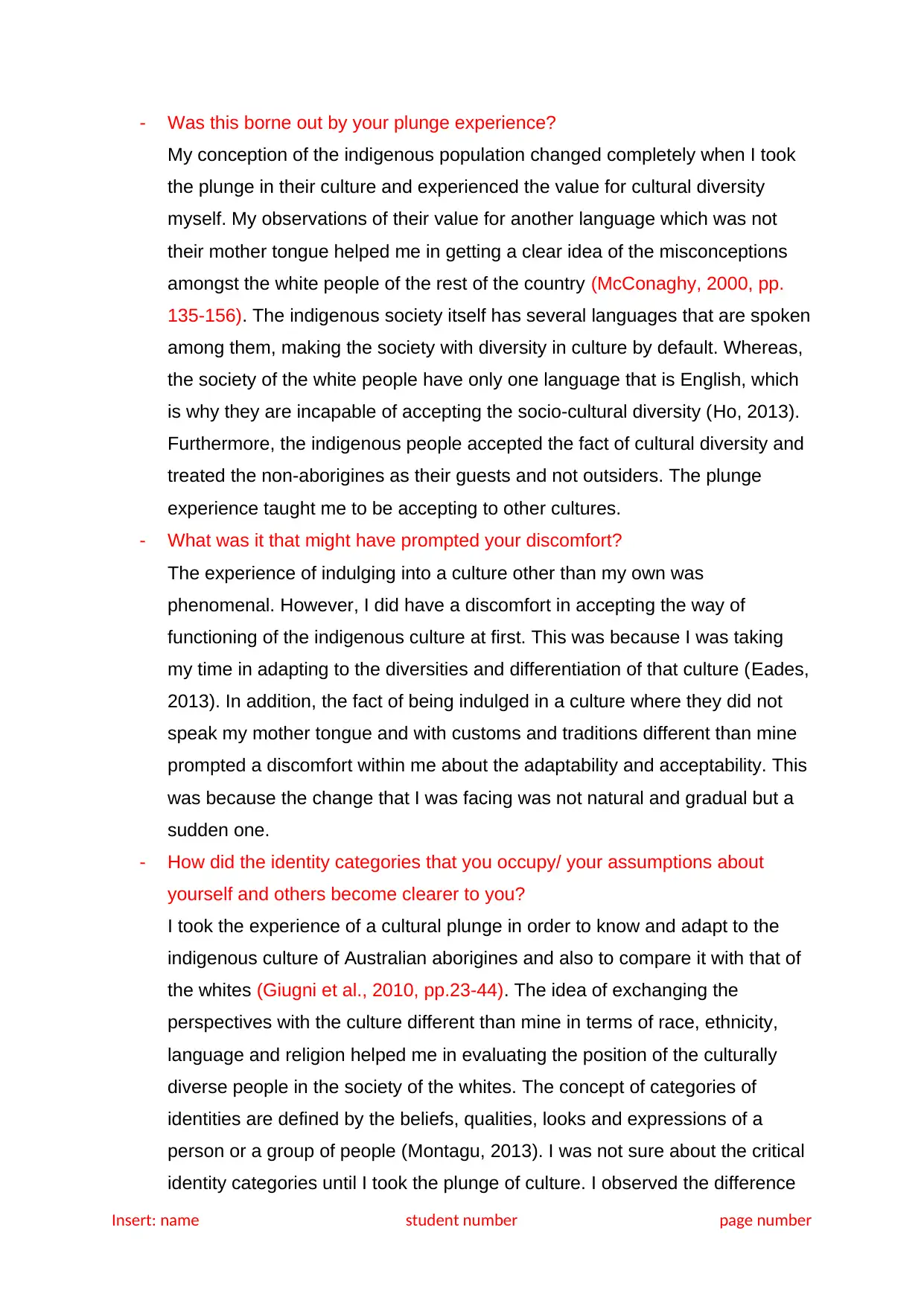
- Was this borne out by your plunge experience?
My conception of the indigenous population changed completely when I took
the plunge in their culture and experienced the value for cultural diversity
myself. My observations of their value for another language which was not
their mother tongue helped me in getting a clear idea of the misconceptions
amongst the white people of the rest of the country (McConaghy, 2000, pp.
135-156). The indigenous society itself has several languages that are spoken
among them, making the society with diversity in culture by default. Whereas,
the society of the white people have only one language that is English, which
is why they are incapable of accepting the socio-cultural diversity (Ho, 2013).
Furthermore, the indigenous people accepted the fact of cultural diversity and
treated the non-aborigines as their guests and not outsiders. The plunge
experience taught me to be accepting to other cultures.
- What was it that might have prompted your discomfort?
The experience of indulging into a culture other than my own was
phenomenal. However, I did have a discomfort in accepting the way of
functioning of the indigenous culture at first. This was because I was taking
my time in adapting to the diversities and differentiation of that culture (Eades,
2013). In addition, the fact of being indulged in a culture where they did not
speak my mother tongue and with customs and traditions different than mine
prompted a discomfort within me about the adaptability and acceptability. This
was because the change that I was facing was not natural and gradual but a
sudden one.
- How did the identity categories that you occupy/ your assumptions about
yourself and others become clearer to you?
I took the experience of a cultural plunge in order to know and adapt to the
indigenous culture of Australian aborigines and also to compare it with that of
the whites (Giugni et al., 2010, pp.23-44). The idea of exchanging the
perspectives with the culture different than mine in terms of race, ethnicity,
language and religion helped me in evaluating the position of the culturally
diverse people in the society of the whites. The concept of categories of
identities are defined by the beliefs, qualities, looks and expressions of a
person or a group of people (Montagu, 2013). I was not sure about the critical
identity categories until I took the plunge of culture. I observed the difference
Insert: name student number page number
My conception of the indigenous population changed completely when I took
the plunge in their culture and experienced the value for cultural diversity
myself. My observations of their value for another language which was not
their mother tongue helped me in getting a clear idea of the misconceptions
amongst the white people of the rest of the country (McConaghy, 2000, pp.
135-156). The indigenous society itself has several languages that are spoken
among them, making the society with diversity in culture by default. Whereas,
the society of the white people have only one language that is English, which
is why they are incapable of accepting the socio-cultural diversity (Ho, 2013).
Furthermore, the indigenous people accepted the fact of cultural diversity and
treated the non-aborigines as their guests and not outsiders. The plunge
experience taught me to be accepting to other cultures.
- What was it that might have prompted your discomfort?
The experience of indulging into a culture other than my own was
phenomenal. However, I did have a discomfort in accepting the way of
functioning of the indigenous culture at first. This was because I was taking
my time in adapting to the diversities and differentiation of that culture (Eades,
2013). In addition, the fact of being indulged in a culture where they did not
speak my mother tongue and with customs and traditions different than mine
prompted a discomfort within me about the adaptability and acceptability. This
was because the change that I was facing was not natural and gradual but a
sudden one.
- How did the identity categories that you occupy/ your assumptions about
yourself and others become clearer to you?
I took the experience of a cultural plunge in order to know and adapt to the
indigenous culture of Australian aborigines and also to compare it with that of
the whites (Giugni et al., 2010, pp.23-44). The idea of exchanging the
perspectives with the culture different than mine in terms of race, ethnicity,
language and religion helped me in evaluating the position of the culturally
diverse people in the society of the whites. The concept of categories of
identities are defined by the beliefs, qualities, looks and expressions of a
person or a group of people (Montagu, 2013). I was not sure about the critical
identity categories until I took the plunge of culture. I observed the difference
Insert: name student number page number
⊘ This is a preview!⊘
Do you want full access?
Subscribe today to unlock all pages.

Trusted by 1+ million students worldwide

in race, their complexion, their traditions and customs and also their language
for which they are discriminated in the societies of whites.
- What did this experience teach you about yourself and how you might pre-
judge others?
The experience taught me how important it is to practice education of different
cultures in a multicultural society from the early childhood. This will not only
enable the children to learn about different cultures but also to accept the
cultural diversities and eradicate discrimination based on race. The cultural
plunge taught me the importance of education in order to eradicate racial
discrimination (Cheng, 2013). I have learned to accept the cultural diversity
that is present in the society and will not indulge in racial discrimination that is
harmful for achieving a culturally diverse and sustainable society.
- How does all of this connect (or not) to your reading thus far?
I have learned about the importance of early education about cultural
diversities present in a society and how it might help in eliminating the
discrimination based on race and language. In addition, the experience has
been useful in coming into the conclusion that educating the mass is the only
way to eradicate the social evils and that needs to be done from the roots.
The children are the future of a nation and society and providing the correct
education to them about the cultural diversities will help them in seeking
knowledge about the other cultures and in this way, they will learn to accept
the diversities and differences of culture (Forrest & Dunn, 2013). This
experience has taught me how irrelevant discrimination is. It has also
enlightened me about the irrelevance of classification of ‘normal’ and ‘others’
present in the society because the classifications are nothing but a measure
to ensure the presence of discrimination. I feel the benchmarks of
classification and reference should be removed from the society and the idea
of a culturally diverse society should be encouraged.
c) Issues of diversity and difference
Implications for policy, programming, planning, and work with stakeholders – How
might this impact your programming/ planning, centre policies and daily practices?
I have learned how to be more open minded and accepting as a person towards
other cultures after taking the cultural plunge. There is a diversity of languages even
in the indigenous culture itself and this is why the idea of a culturally diverse society
is common to them. They are open minded and socially accepting towards other
Insert: name student number page number
for which they are discriminated in the societies of whites.
- What did this experience teach you about yourself and how you might pre-
judge others?
The experience taught me how important it is to practice education of different
cultures in a multicultural society from the early childhood. This will not only
enable the children to learn about different cultures but also to accept the
cultural diversities and eradicate discrimination based on race. The cultural
plunge taught me the importance of education in order to eradicate racial
discrimination (Cheng, 2013). I have learned to accept the cultural diversity
that is present in the society and will not indulge in racial discrimination that is
harmful for achieving a culturally diverse and sustainable society.
- How does all of this connect (or not) to your reading thus far?
I have learned about the importance of early education about cultural
diversities present in a society and how it might help in eliminating the
discrimination based on race and language. In addition, the experience has
been useful in coming into the conclusion that educating the mass is the only
way to eradicate the social evils and that needs to be done from the roots.
The children are the future of a nation and society and providing the correct
education to them about the cultural diversities will help them in seeking
knowledge about the other cultures and in this way, they will learn to accept
the diversities and differences of culture (Forrest & Dunn, 2013). This
experience has taught me how irrelevant discrimination is. It has also
enlightened me about the irrelevance of classification of ‘normal’ and ‘others’
present in the society because the classifications are nothing but a measure
to ensure the presence of discrimination. I feel the benchmarks of
classification and reference should be removed from the society and the idea
of a culturally diverse society should be encouraged.
c) Issues of diversity and difference
Implications for policy, programming, planning, and work with stakeholders – How
might this impact your programming/ planning, centre policies and daily practices?
I have learned how to be more open minded and accepting as a person towards
other cultures after taking the cultural plunge. There is a diversity of languages even
in the indigenous culture itself and this is why the idea of a culturally diverse society
is common to them. They are open minded and socially accepting towards other
Insert: name student number page number
Paraphrase This Document
Need a fresh take? Get an instant paraphrase of this document with our AI Paraphraser
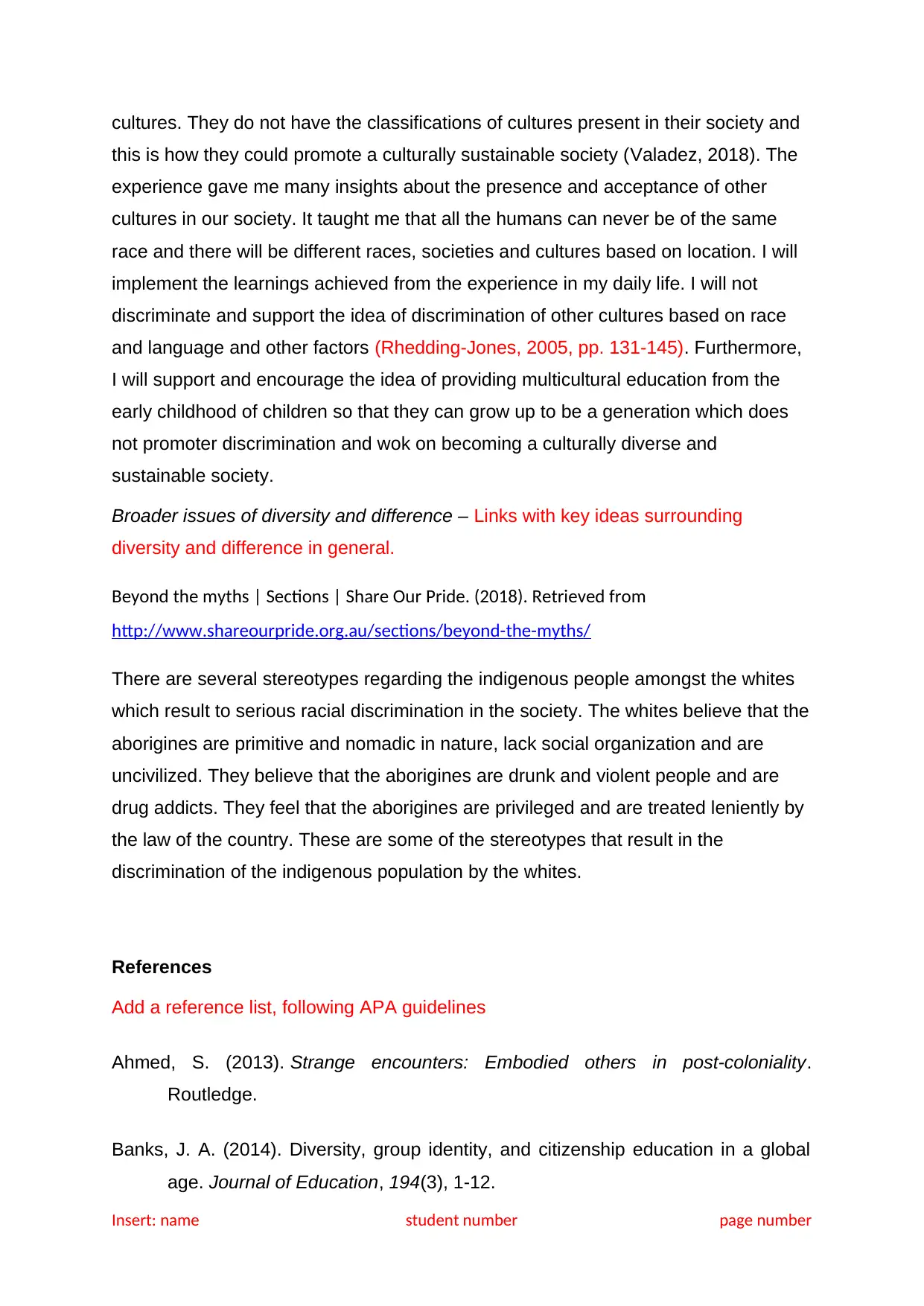
cultures. They do not have the classifications of cultures present in their society and
this is how they could promote a culturally sustainable society (Valadez, 2018). The
experience gave me many insights about the presence and acceptance of other
cultures in our society. It taught me that all the humans can never be of the same
race and there will be different races, societies and cultures based on location. I will
implement the learnings achieved from the experience in my daily life. I will not
discriminate and support the idea of discrimination of other cultures based on race
and language and other factors (Rhedding-Jones, 2005, pp. 131-145). Furthermore,
I will support and encourage the idea of providing multicultural education from the
early childhood of children so that they can grow up to be a generation which does
not promoter discrimination and wok on becoming a culturally diverse and
sustainable society.
Broader issues of diversity and difference – Links with key ideas surrounding
diversity and difference in general.
Beyond the myths | Sections | Share Our Pride. (2018). Retrieved from
http://www.shareourpride.org.au/sections/beyond-the-myths/
There are several stereotypes regarding the indigenous people amongst the whites
which result to serious racial discrimination in the society. The whites believe that the
aborigines are primitive and nomadic in nature, lack social organization and are
uncivilized. They believe that the aborigines are drunk and violent people and are
drug addicts. They feel that the aborigines are privileged and are treated leniently by
the law of the country. These are some of the stereotypes that result in the
discrimination of the indigenous population by the whites.
References
Add a reference list, following APA guidelines
Ahmed, S. (2013). Strange encounters: Embodied others in post-coloniality.
Routledge.
Banks, J. A. (2014). Diversity, group identity, and citizenship education in a global
age. Journal of Education, 194(3), 1-12.
Insert: name student number page number
this is how they could promote a culturally sustainable society (Valadez, 2018). The
experience gave me many insights about the presence and acceptance of other
cultures in our society. It taught me that all the humans can never be of the same
race and there will be different races, societies and cultures based on location. I will
implement the learnings achieved from the experience in my daily life. I will not
discriminate and support the idea of discrimination of other cultures based on race
and language and other factors (Rhedding-Jones, 2005, pp. 131-145). Furthermore,
I will support and encourage the idea of providing multicultural education from the
early childhood of children so that they can grow up to be a generation which does
not promoter discrimination and wok on becoming a culturally diverse and
sustainable society.
Broader issues of diversity and difference – Links with key ideas surrounding
diversity and difference in general.
Beyond the myths | Sections | Share Our Pride. (2018). Retrieved from
http://www.shareourpride.org.au/sections/beyond-the-myths/
There are several stereotypes regarding the indigenous people amongst the whites
which result to serious racial discrimination in the society. The whites believe that the
aborigines are primitive and nomadic in nature, lack social organization and are
uncivilized. They believe that the aborigines are drunk and violent people and are
drug addicts. They feel that the aborigines are privileged and are treated leniently by
the law of the country. These are some of the stereotypes that result in the
discrimination of the indigenous population by the whites.
References
Add a reference list, following APA guidelines
Ahmed, S. (2013). Strange encounters: Embodied others in post-coloniality.
Routledge.
Banks, J. A. (2014). Diversity, group identity, and citizenship education in a global
age. Journal of Education, 194(3), 1-12.
Insert: name student number page number
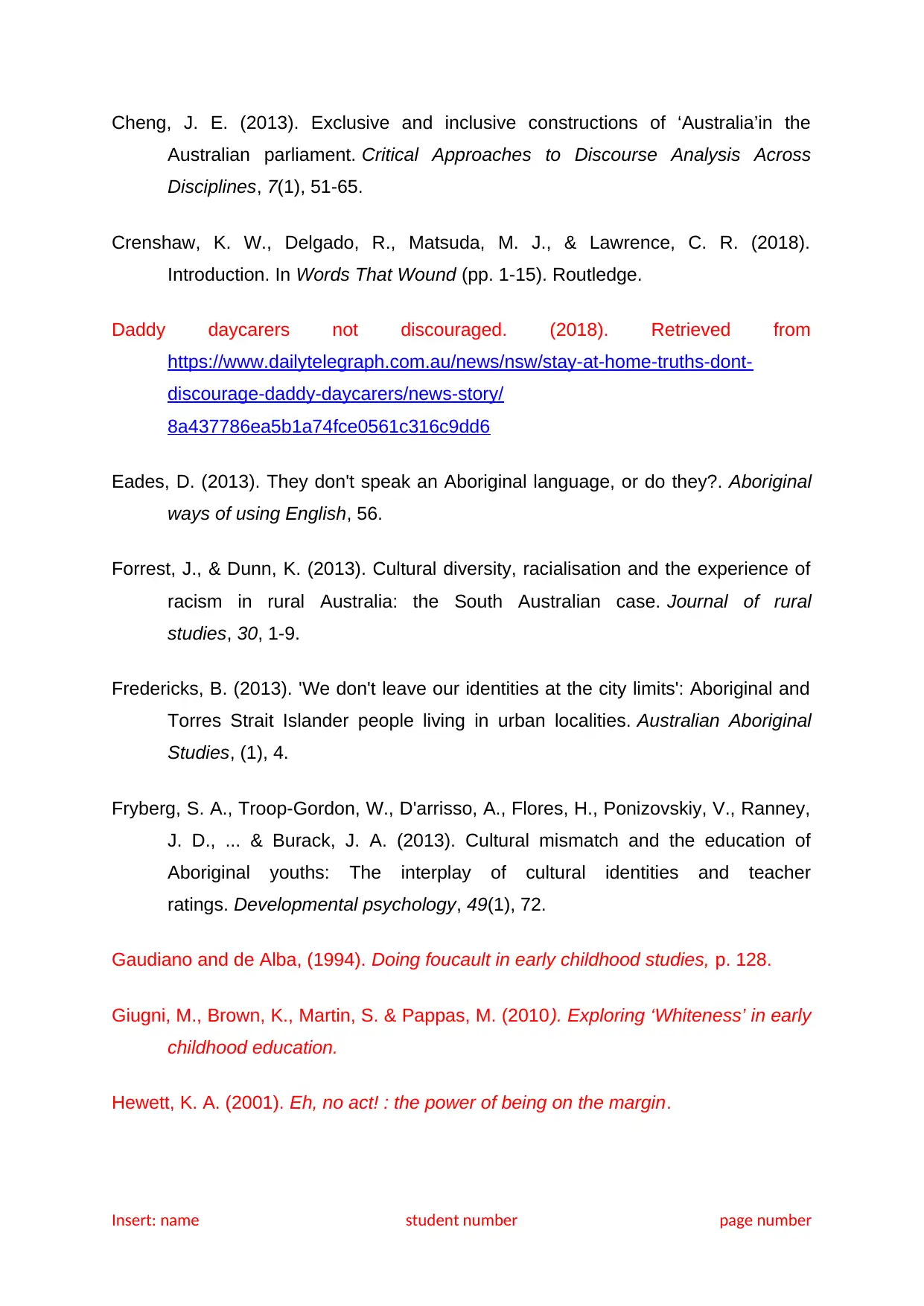
Cheng, J. E. (2013). Exclusive and inclusive constructions of ‘Australia’in the
Australian parliament. Critical Approaches to Discourse Analysis Across
Disciplines, 7(1), 51-65.
Crenshaw, K. W., Delgado, R., Matsuda, M. J., & Lawrence, C. R. (2018).
Introduction. In Words That Wound (pp. 1-15). Routledge.
Daddy daycarers not discouraged. (2018). Retrieved from
https://www.dailytelegraph.com.au/news/nsw/stay-at-home-truths-dont-
discourage-daddy-daycarers/news-story/
8a437786ea5b1a74fce0561c316c9dd6
Eades, D. (2013). They don't speak an Aboriginal language, or do they?. Aboriginal
ways of using English, 56.
Forrest, J., & Dunn, K. (2013). Cultural diversity, racialisation and the experience of
racism in rural Australia: the South Australian case. Journal of rural
studies, 30, 1-9.
Fredericks, B. (2013). 'We don't leave our identities at the city limits': Aboriginal and
Torres Strait Islander people living in urban localities. Australian Aboriginal
Studies, (1), 4.
Fryberg, S. A., Troop-Gordon, W., D'arrisso, A., Flores, H., Ponizovskiy, V., Ranney,
J. D., ... & Burack, J. A. (2013). Cultural mismatch and the education of
Aboriginal youths: The interplay of cultural identities and teacher
ratings. Developmental psychology, 49(1), 72.
Gaudiano and de Alba, (1994). Doing foucault in early childhood studies, p. 128.
Giugni, M., Brown, K., Martin, S. & Pappas, M. (2010). Exploring ‘Whiteness’ in early
childhood education.
Hewett, K. A. (2001). Eh, no act! : the power of being on the margin.
Insert: name student number page number
Australian parliament. Critical Approaches to Discourse Analysis Across
Disciplines, 7(1), 51-65.
Crenshaw, K. W., Delgado, R., Matsuda, M. J., & Lawrence, C. R. (2018).
Introduction. In Words That Wound (pp. 1-15). Routledge.
Daddy daycarers not discouraged. (2018). Retrieved from
https://www.dailytelegraph.com.au/news/nsw/stay-at-home-truths-dont-
discourage-daddy-daycarers/news-story/
8a437786ea5b1a74fce0561c316c9dd6
Eades, D. (2013). They don't speak an Aboriginal language, or do they?. Aboriginal
ways of using English, 56.
Forrest, J., & Dunn, K. (2013). Cultural diversity, racialisation and the experience of
racism in rural Australia: the South Australian case. Journal of rural
studies, 30, 1-9.
Fredericks, B. (2013). 'We don't leave our identities at the city limits': Aboriginal and
Torres Strait Islander people living in urban localities. Australian Aboriginal
Studies, (1), 4.
Fryberg, S. A., Troop-Gordon, W., D'arrisso, A., Flores, H., Ponizovskiy, V., Ranney,
J. D., ... & Burack, J. A. (2013). Cultural mismatch and the education of
Aboriginal youths: The interplay of cultural identities and teacher
ratings. Developmental psychology, 49(1), 72.
Gaudiano and de Alba, (1994). Doing foucault in early childhood studies, p. 128.
Giugni, M., Brown, K., Martin, S. & Pappas, M. (2010). Exploring ‘Whiteness’ in early
childhood education.
Hewett, K. A. (2001). Eh, no act! : the power of being on the margin.
Insert: name student number page number
⊘ This is a preview!⊘
Do you want full access?
Subscribe today to unlock all pages.

Trusted by 1+ million students worldwide
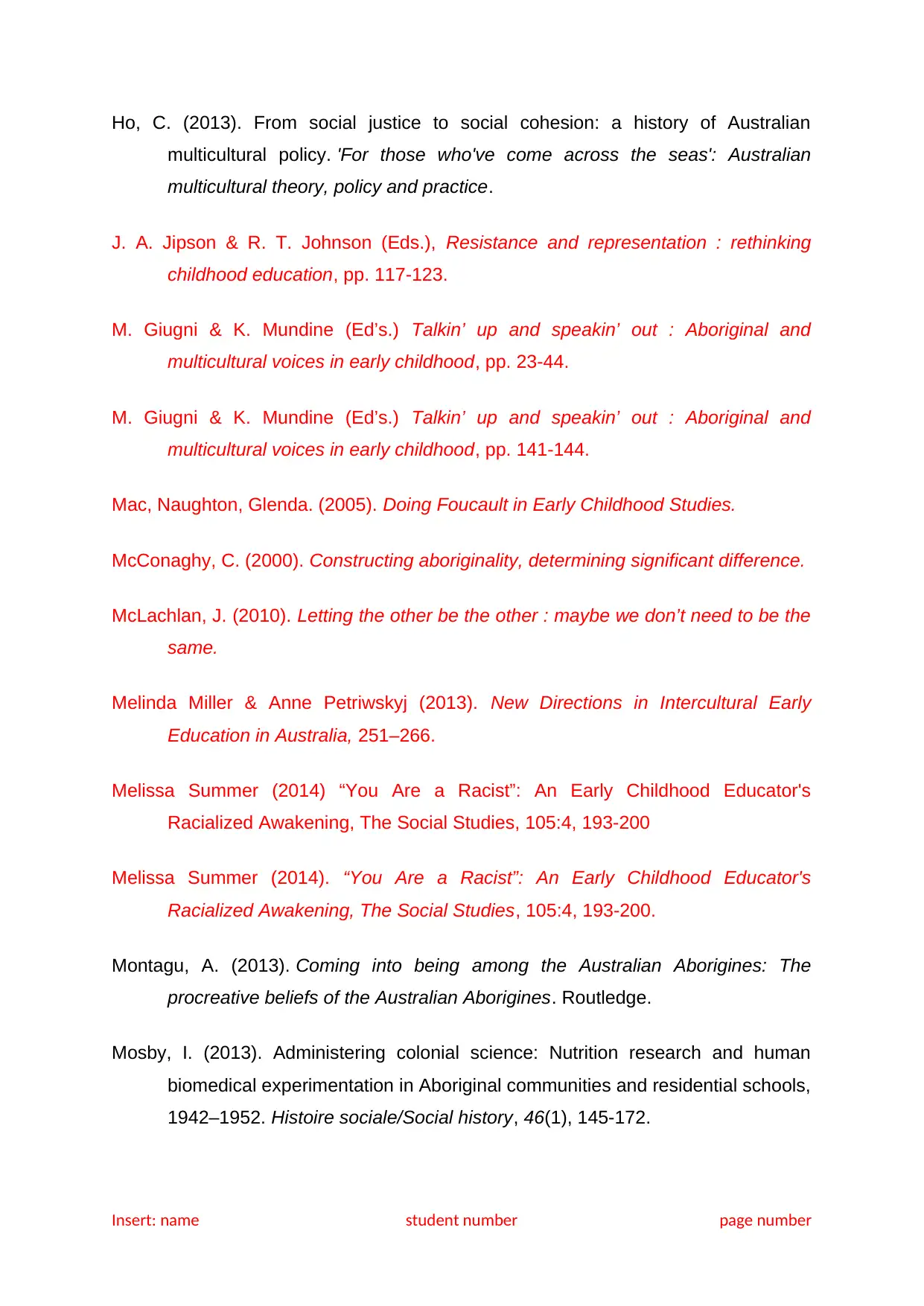
Ho, C. (2013). From social justice to social cohesion: a history of Australian
multicultural policy. 'For those who've come across the seas': Australian
multicultural theory, policy and practice.
J. A. Jipson & R. T. Johnson (Eds.), Resistance and representation : rethinking
childhood education, pp. 117-123.
M. Giugni & K. Mundine (Ed’s.) Talkin’ up and speakin’ out : Aboriginal and
multicultural voices in early childhood, pp. 23-44.
M. Giugni & K. Mundine (Ed’s.) Talkin’ up and speakin’ out : Aboriginal and
multicultural voices in early childhood, pp. 141-144.
Mac, Naughton, Glenda. (2005). Doing Foucault in Early Childhood Studies.
McConaghy, C. (2000). Constructing aboriginality, determining significant difference.
McLachlan, J. (2010). Letting the other be the other : maybe we don’t need to be the
same.
Melinda Miller & Anne Petriwskyj (2013). New Directions in Intercultural Early
Education in Australia, 251–266.
Melissa Summer (2014) “You Are a Racist”: An Early Childhood Educator's
Racialized Awakening, The Social Studies, 105:4, 193-200
Melissa Summer (2014). “You Are a Racist”: An Early Childhood Educator's
Racialized Awakening, The Social Studies, 105:4, 193-200.
Montagu, A. (2013). Coming into being among the Australian Aborigines: The
procreative beliefs of the Australian Aborigines. Routledge.
Mosby, I. (2013). Administering colonial science: Nutrition research and human
biomedical experimentation in Aboriginal communities and residential schools,
1942–1952. Histoire sociale/Social history, 46(1), 145-172.
Insert: name student number page number
multicultural policy. 'For those who've come across the seas': Australian
multicultural theory, policy and practice.
J. A. Jipson & R. T. Johnson (Eds.), Resistance and representation : rethinking
childhood education, pp. 117-123.
M. Giugni & K. Mundine (Ed’s.) Talkin’ up and speakin’ out : Aboriginal and
multicultural voices in early childhood, pp. 23-44.
M. Giugni & K. Mundine (Ed’s.) Talkin’ up and speakin’ out : Aboriginal and
multicultural voices in early childhood, pp. 141-144.
Mac, Naughton, Glenda. (2005). Doing Foucault in Early Childhood Studies.
McConaghy, C. (2000). Constructing aboriginality, determining significant difference.
McLachlan, J. (2010). Letting the other be the other : maybe we don’t need to be the
same.
Melinda Miller & Anne Petriwskyj (2013). New Directions in Intercultural Early
Education in Australia, 251–266.
Melissa Summer (2014) “You Are a Racist”: An Early Childhood Educator's
Racialized Awakening, The Social Studies, 105:4, 193-200
Melissa Summer (2014). “You Are a Racist”: An Early Childhood Educator's
Racialized Awakening, The Social Studies, 105:4, 193-200.
Montagu, A. (2013). Coming into being among the Australian Aborigines: The
procreative beliefs of the Australian Aborigines. Routledge.
Mosby, I. (2013). Administering colonial science: Nutrition research and human
biomedical experimentation in Aboriginal communities and residential schools,
1942–1952. Histoire sociale/Social history, 46(1), 145-172.
Insert: name student number page number
Paraphrase This Document
Need a fresh take? Get an instant paraphrase of this document with our AI Paraphraser
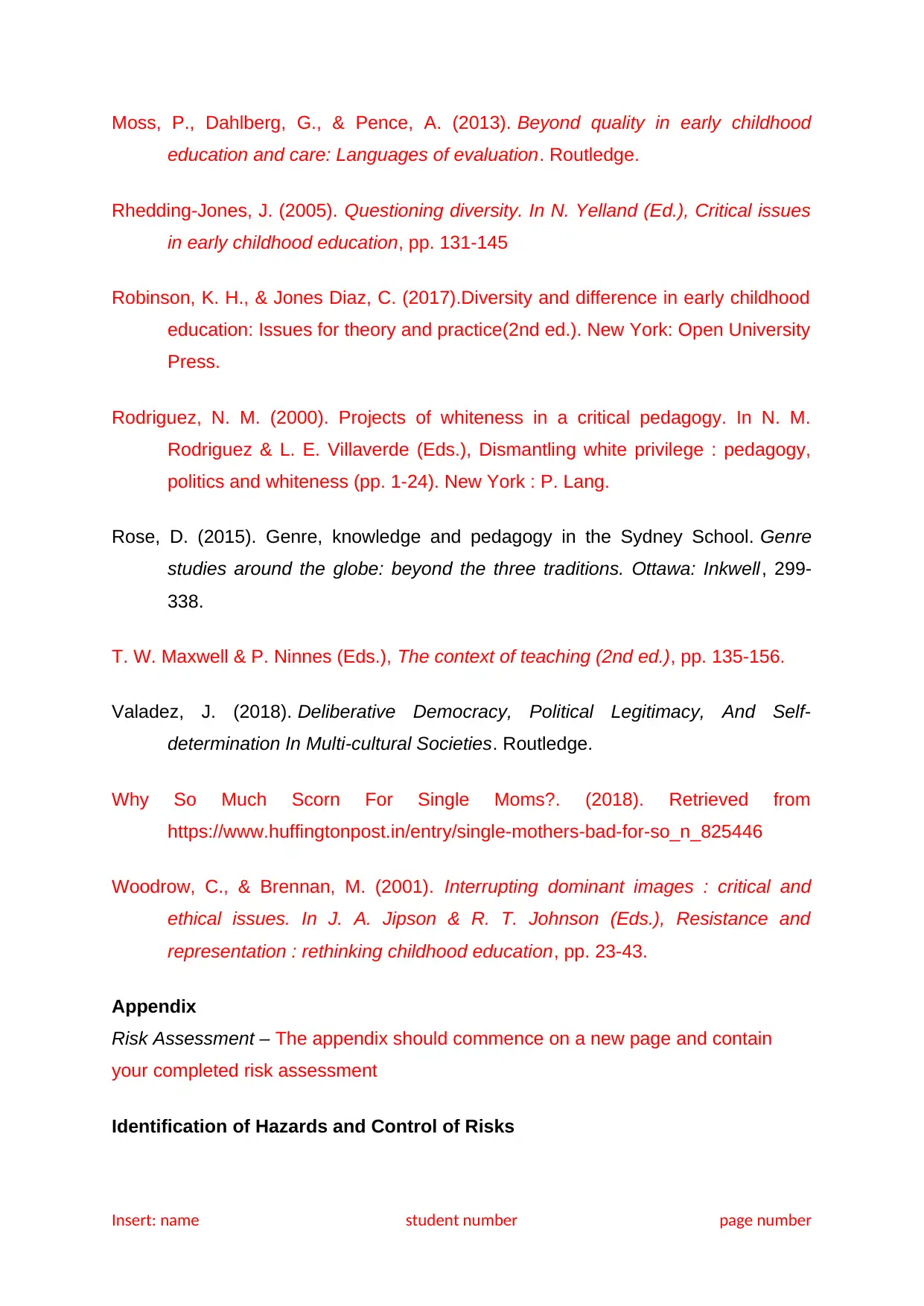
Moss, P., Dahlberg, G., & Pence, A. (2013). Beyond quality in early childhood
education and care: Languages of evaluation. Routledge.
Rhedding-Jones, J. (2005). Questioning diversity. In N. Yelland (Ed.), Critical issues
in early childhood education, pp. 131-145
Robinson, K. H., & Jones Diaz, C. (2017).Diversity and difference in early childhood
education: Issues for theory and practice(2nd ed.). New York: Open University
Press.
Rodriguez, N. M. (2000). Projects of whiteness in a critical pedagogy. In N. M.
Rodriguez & L. E. Villaverde (Eds.), Dismantling white privilege : pedagogy,
politics and whiteness (pp. 1-24). New York : P. Lang.
Rose, D. (2015). Genre, knowledge and pedagogy in the Sydney School. Genre
studies around the globe: beyond the three traditions. Ottawa: Inkwell, 299-
338.
T. W. Maxwell & P. Ninnes (Eds.), The context of teaching (2nd ed.), pp. 135-156.
Valadez, J. (2018). Deliberative Democracy, Political Legitimacy, And Self-
determination In Multi-cultural Societies. Routledge.
Why So Much Scorn For Single Moms?. (2018). Retrieved from
https://www.huffingtonpost.in/entry/single-mothers-bad-for-so_n_825446
Woodrow, C., & Brennan, M. (2001). Interrupting dominant images : critical and
ethical issues. In J. A. Jipson & R. T. Johnson (Eds.), Resistance and
representation : rethinking childhood education, pp. 23-43.
Appendix
Risk Assessment – The appendix should commence on a new page and contain
your completed risk assessment
Identification of Hazards and Control of Risks
Insert: name student number page number
education and care: Languages of evaluation. Routledge.
Rhedding-Jones, J. (2005). Questioning diversity. In N. Yelland (Ed.), Critical issues
in early childhood education, pp. 131-145
Robinson, K. H., & Jones Diaz, C. (2017).Diversity and difference in early childhood
education: Issues for theory and practice(2nd ed.). New York: Open University
Press.
Rodriguez, N. M. (2000). Projects of whiteness in a critical pedagogy. In N. M.
Rodriguez & L. E. Villaverde (Eds.), Dismantling white privilege : pedagogy,
politics and whiteness (pp. 1-24). New York : P. Lang.
Rose, D. (2015). Genre, knowledge and pedagogy in the Sydney School. Genre
studies around the globe: beyond the three traditions. Ottawa: Inkwell, 299-
338.
T. W. Maxwell & P. Ninnes (Eds.), The context of teaching (2nd ed.), pp. 135-156.
Valadez, J. (2018). Deliberative Democracy, Political Legitimacy, And Self-
determination In Multi-cultural Societies. Routledge.
Why So Much Scorn For Single Moms?. (2018). Retrieved from
https://www.huffingtonpost.in/entry/single-mothers-bad-for-so_n_825446
Woodrow, C., & Brennan, M. (2001). Interrupting dominant images : critical and
ethical issues. In J. A. Jipson & R. T. Johnson (Eds.), Resistance and
representation : rethinking childhood education, pp. 23-43.
Appendix
Risk Assessment – The appendix should commence on a new page and contain
your completed risk assessment
Identification of Hazards and Control of Risks
Insert: name student number page number
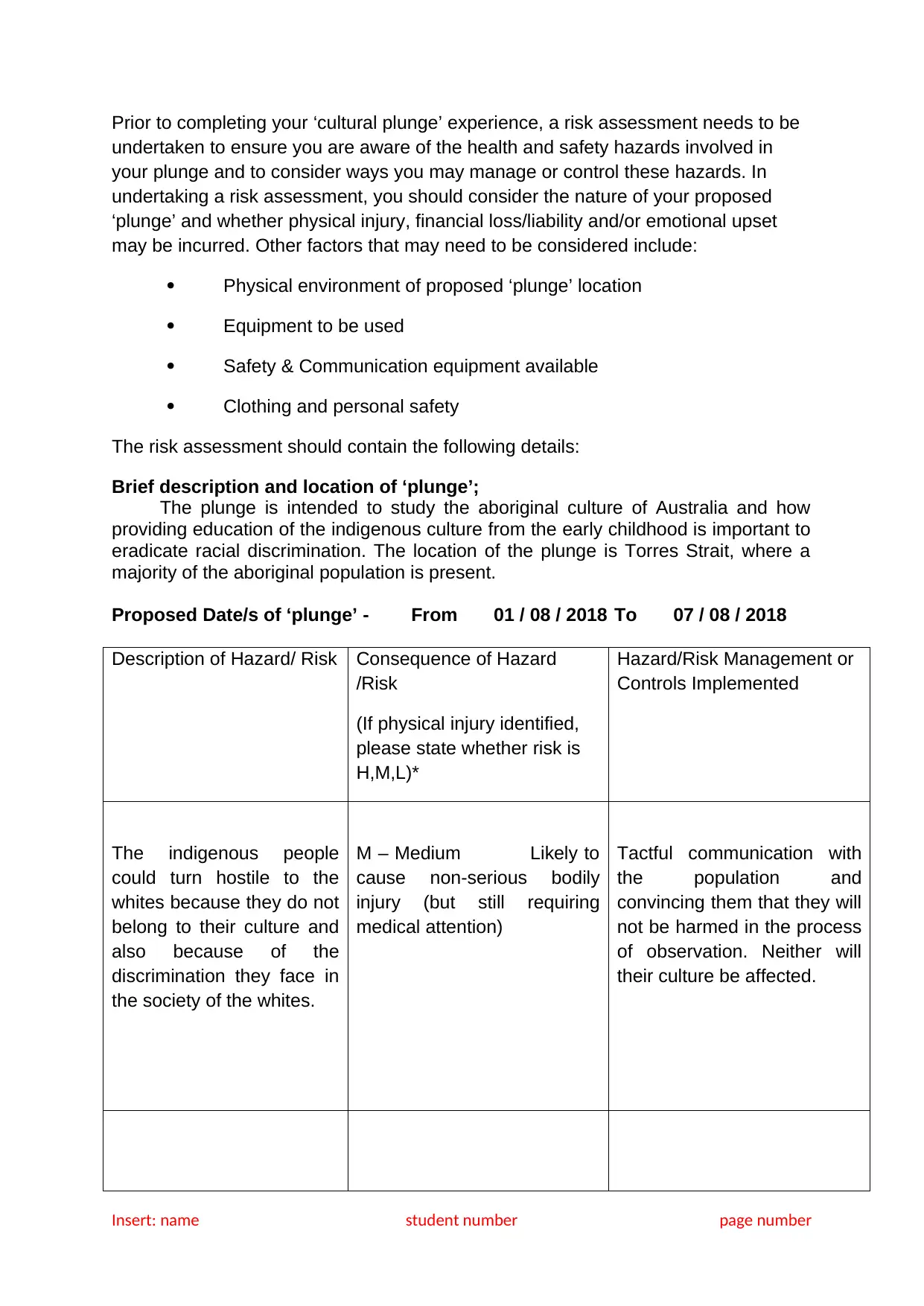
Prior to completing your ‘cultural plunge’ experience, a risk assessment needs to be
undertaken to ensure you are aware of the health and safety hazards involved in
your plunge and to consider ways you may manage or control these hazards. In
undertaking a risk assessment, you should consider the nature of your proposed
‘plunge’ and whether physical injury, financial loss/liability and/or emotional upset
may be incurred. Other factors that may need to be considered include:
Physical environment of proposed ‘plunge’ location
Equipment to be used
Safety & Communication equipment available
Clothing and personal safety
The risk assessment should contain the following details:
Brief description and location of ‘plunge’;
The plunge is intended to study the aboriginal culture of Australia and how
providing education of the indigenous culture from the early childhood is important to
eradicate racial discrimination. The location of the plunge is Torres Strait, where a
majority of the aboriginal population is present.
Proposed Date/s of ‘plunge’ - From 01 / 08 / 2018 To 07 / 08 / 2018
Description of Hazard/ Risk Consequence of Hazard
/Risk
(If physical injury identified,
please state whether risk is
H,M,L)*
Hazard/Risk Management or
Controls Implemented
The indigenous people
could turn hostile to the
whites because they do not
belong to their culture and
also because of the
discrimination they face in
the society of the whites.
M – Medium Likely to
cause non-serious bodily
injury (but still requiring
medical attention)
Tactful communication with
the population and
convincing them that they will
not be harmed in the process
of observation. Neither will
their culture be affected.
Insert: name student number page number
undertaken to ensure you are aware of the health and safety hazards involved in
your plunge and to consider ways you may manage or control these hazards. In
undertaking a risk assessment, you should consider the nature of your proposed
‘plunge’ and whether physical injury, financial loss/liability and/or emotional upset
may be incurred. Other factors that may need to be considered include:
Physical environment of proposed ‘plunge’ location
Equipment to be used
Safety & Communication equipment available
Clothing and personal safety
The risk assessment should contain the following details:
Brief description and location of ‘plunge’;
The plunge is intended to study the aboriginal culture of Australia and how
providing education of the indigenous culture from the early childhood is important to
eradicate racial discrimination. The location of the plunge is Torres Strait, where a
majority of the aboriginal population is present.
Proposed Date/s of ‘plunge’ - From 01 / 08 / 2018 To 07 / 08 / 2018
Description of Hazard/ Risk Consequence of Hazard
/Risk
(If physical injury identified,
please state whether risk is
H,M,L)*
Hazard/Risk Management or
Controls Implemented
The indigenous people
could turn hostile to the
whites because they do not
belong to their culture and
also because of the
discrimination they face in
the society of the whites.
M – Medium Likely to
cause non-serious bodily
injury (but still requiring
medical attention)
Tactful communication with
the population and
convincing them that they will
not be harmed in the process
of observation. Neither will
their culture be affected.
Insert: name student number page number
⊘ This is a preview!⊘
Do you want full access?
Subscribe today to unlock all pages.

Trusted by 1+ million students worldwide
1 out of 13
Related Documents
Your All-in-One AI-Powered Toolkit for Academic Success.
+13062052269
info@desklib.com
Available 24*7 on WhatsApp / Email
![[object Object]](/_next/static/media/star-bottom.7253800d.svg)
Unlock your academic potential
Copyright © 2020–2025 A2Z Services. All Rights Reserved. Developed and managed by ZUCOL.




